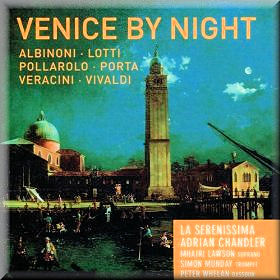 |
 |
| 
Buy
through MusicWeb
for £12.49 postage paid World-wide.
Musicweb
Purchase button |
Venice by Night
ANONYMOUS
Si la gondola avere [3:40]
Cara Nina el bon to sesto for soprano and guitar [2:00]
No stè a condanarme for soprano and continuo [1:44]
Carlo Francesco POLLAROLO (c.1653-1723)
La Vendetta d'Amore; Sinfonia for trumpet, strings and continuo
[3:10]
Tomaso ALBINONI (1671-1751)
Sinfonia for strings and continuo in G minor Si 7 [6:01]
Sinfonia to Il Nome Glorioso in Terra Santificat in Cielo [4:20]
Antonio VIVALDI (1678-1741)
Concerto for bassoon, strings and continuo in C RV 477 [11:20]
Concerto for violin, strings and continuo in E minor, RV 278 [14:54]
L' Olimpiade, RV 725; Recitativo. Pria dell'esito
ancor [0:32]: Aria. Largo. Il fidarsi della spene [6:30]
Montezuma, RV 723; Recitativo. Act 2, Scene 5. Mi deride, mi sprezza
[0:30]: Act 2, Scene 5. Aria. Allegro. D'ira e furor armato
[4:52]
Francesco Maria VERACINI (1690-1768)
Fuga, o capriccio con quattro soggetti in D minor for strings and
continuo [3:05]
Antonio LOTTI (c1667-1740)
Alma ride exulta mortalis; Motet for soprano, strings and continuo
[12:28]
Giovanni PORTA (c.1677-1755)
Sinfonia for trumpet, strings and continuo in D [4:13]
 Mhairi Lawson (soprano); Simon Munday (trumpet); Peter Whelan (bassoon)
Mhairi Lawson (soprano); Simon Munday (trumpet); Peter Whelan (bassoon)
La Serenissima/Adrian Chandler (violin and director)
rec. February 2012, the Hospital of St Cross, Winchester
 AVIE AV2257 [79:47]
AVIE AV2257 [79:47]
|
|
|
This imaginatively programmed disc takes us on a nocturnal Venetian
visit. Its breadth of programming ensures that a number of important
genres are encountered, not least concert and operatic performances,
and if one is still left musically unsated, one can always enjoy
ecclesiastical and private music soirées whilst in the city.
Not the least of the charms of the disc is that – with no disrespect
to the Red Priest – other composers’ works are explored in addition
to Vivaldi’s. In short, there is Venetian variety on display.
This thematic arrangement – gondola, concert, church and the
others – brings a kaleidoscopic approach to music in the city.
But for all its august status Venice also admits our old friend
Anon. The Gondola conceit allows anonymous vocal settings, sung
by Mhairi Lawson with varying accompaniments. Brief though they
are, they prove charmingly ingratiating. ‘A Private Concert’
introduces Pollarolo’s Sinfonia, a 1707 work largely recycled
from an opera. It’s dispatched by trumpeter Simon Munday with
commendable authority and no little panache. We also hear
Albinoni’s Sinfonia in G minor, with a characteristically lovely
slow movement. This private concert ends with Vivaldi’s Bassoon
Concerto in C RV477, played in a communicatively chuntering
style by Peter Whelan. The slow movement with its yearning
ascending line is particularly attractive.
If you need spiritual nourishment, Music for Compline opens
the door to Veracini’s Fuga for strings and continuo, a crisp
polyphonic piece played with strong string articulation. This
work prefaces Antonio Lotti’s motet, Alma ride exulta mortalis.
This Feast Day motet reveals once again how adept was Lotti
at vocal settings. The highlight of this compact piece is surely
the ritornello-adagio with its ‘rolling’ lyric line and hugely
sympathetic melodic curve. An interlude is provided in ‘A Concert
from the ospedale della Pietá, in which the musical tourist
can enjoy Vivaldi’s Violin Concerto in E minor RV278 played
by Adam Chandler, the soloist and director of La Serenissima.
It’s shaped with real sensitivity, and proves a highly musical
study in the Venetian art. Finally we arrive at ‘The Opera House’.
We hear Giovanni Porta’s Sinfonia in D where Munday is once
again heard to strong effect. And then finally it’s back to
Vivaldi for two arias written for the castrato Marianino Nicolini.
The aria from L’Olimpiade is rather beautiful, whilst
that from Motezuma is visited by many a harmonic twist
and turn and imbued with plenty of drama. Lawson sings arias
and recitatives with attention to textual detail and in unobtrusively
excellent style.
It’s certainly worth adding that the pieces by Pollarolo, Veracini,
Lotti and Porta are noted as being first-ever recordings.
The recordings, made in the Hospital of St Cross in Winchester,
are first class and the notes – with full texts and translations
– equally. This engaging journey, whether on land or on sea,
proves highly successful.
Jonathan Woolf
|
|

